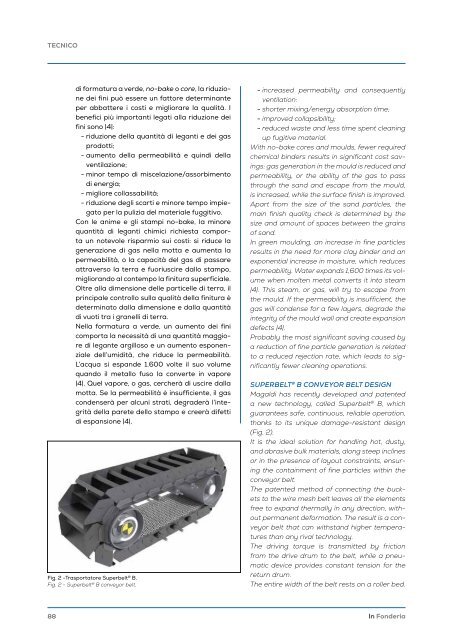In Fonderia 1 2024
Primo numero del 2024 di In Fonderia
Primo numero del 2024 di In Fonderia
Create successful ePaper yourself
Turn your PDF publications into a flip-book with our unique Google optimized e-Paper software.
TECNICO<br />
di formatura a verde, no-bake o core, la riduzione<br />
dei fini può essere un fattore determinante<br />
per abbattere i costi e migliorare la qualità. I<br />
benefici più importanti legati alla riduzione dei<br />
fini sono |4|:<br />
- riduzione della quantità di leganti e dei gas<br />
prodotti;<br />
- aumento della permeabilità e quindi della<br />
ventilazione;<br />
- minor tempo di miscelazione/assorbimento<br />
di energia;<br />
- migliore collassabilità;<br />
- riduzione degli scarti e minore tempo impiegato<br />
per la pulizia del materiale fuggitivo.<br />
Con le anime e gli stampi no-bake, la minore<br />
quantità di leganti chimici richiesta comporta<br />
un notevole risparmio sui costi: si riduce la<br />
generazione di gas nella motta e aumenta la<br />
permeabilità, o la capacità del gas di passare<br />
attraverso la terra e fuoriuscire dallo stampo,<br />
migliorando al contempo la finitura superficiale.<br />
Oltre alla dimensione delle particelle di terra, il<br />
principale controllo sulla qualità della finitura è<br />
determinato dalla dimensione e dalla quantità<br />
di vuoti tra i granelli di terra.<br />
Nella formatura a verde, un aumento dei fini<br />
comporta la necessità di una quantità maggiore<br />
di legante argilloso e un aumento esponenziale<br />
dell’umidità, che riduce la permeabilità.<br />
L’acqua si espande 1.600 volte il suo volume<br />
quando il metallo fuso la converte in vapore<br />
|4|. Quel vapore, o gas, cercherà di uscire dalla<br />
motta. Se la permeabilità è insufficiente, il gas<br />
condenserà per alcuni strati, degraderà l’integrità<br />
della parete dello stampo e creerà difetti<br />
di espansione |4|.<br />
Fig. 2 -Trasportatore Superbelt ® B.<br />
Fig. 2 - Superbelt ® B conveyor belt.<br />
- increased permeability and consequently<br />
ventilation:<br />
- shorter mixing/energy absorption time;<br />
- improved collapsibility;<br />
- reduced waste and less time spent cleaning<br />
up fugitive material.<br />
With no-bake cores and moulds, fewer required<br />
chemical binders results in significant cost savings:<br />
gas generation in the mould is reduced and<br />
permeability, or the ability of the gas to pass<br />
through the sand and escape from the mould,<br />
is increased, while the surface finish is improved.<br />
Apart from the size of the sand particles, the<br />
main finish quality check is determined by the<br />
size and amount of spaces between the grains<br />
of sand.<br />
<strong>In</strong> green moulding, an increase in fine particles<br />
results in the need for more clay binder and an<br />
exponential increase in moisture, which reduces<br />
permeability. Water expands 1,600 times its volume<br />
when molten metal converts it into steam<br />
|4|. This steam, or gas, will try to escape from<br />
the mould. If the permeability is insufficient, the<br />
gas will condense for a few layers, degrade the<br />
integrity of the mould wall and create expansion<br />
defects |4|.<br />
Probably the most significant saving caused by<br />
a reduction of fine particle generation is related<br />
to a reduced rejection rate, which leads to significantly<br />
fewer cleaning operations.<br />
SUPERBELT ® B CONVEYOR BELT DESIGN<br />
Magaldi has recently developed and patented<br />
a new technology, called Superbelt ® B, which<br />
guarantees safe, continuous, reliable operation,<br />
thanks to its unique damage-resistant design<br />
(Fig. 2).<br />
It is the ideal solution for handling hot, dusty,<br />
and abrasive bulk materials, along steep inclines<br />
or in the presence of layout constraints, ensuring<br />
the containment of fine particles within the<br />
conveyor belt.<br />
The patented method of connecting the buckets<br />
to the wire mesh belt leaves all the elements<br />
free to expand thermally in any direction, without<br />
permanent deformation. The result is a conveyor<br />
belt that can withstand higher temperatures<br />
than any rival technology.<br />
The driving torque is transmitted by friction<br />
from the drive drum to the belt, while a pneumatic<br />
device provides constant tension for the<br />
return drum.<br />
The entire width of the belt rests on a roller bed.<br />
88<br />
<strong>In</strong> <strong>Fonderia</strong>














